MetaV Explorer


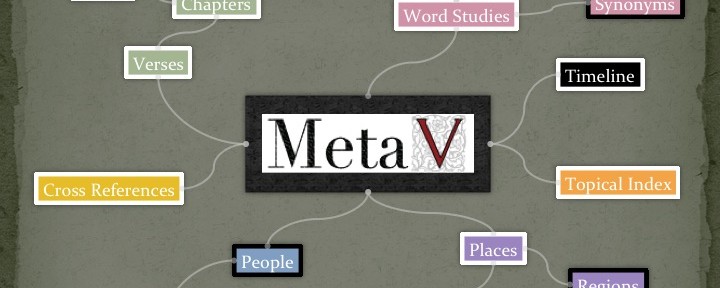

MetaV is the name given to the underlying database used to build the visual Bible explorer on this website and several other infographics. It links together details on people, places, periods of time, and passages in the Bible at word-level detail. This database is specially structured to simplify complex “big picture” analysis or visualizing biblical information.
You can track version history here or fork the GitHub repository.
Above all, the Bible represents absolute truth given from God. The electronic source text of the Bible has been checked for accuracy against multiple other electronic sources of the King James Version using modern text comparison software. The rest of the information in MetaV is nothing more than well-studied conclusions about the Bible formulated and trusted by faithful Christians over the centuries. For more details on original sources, reference the database documentation available in the readme file (included in the downloads below).
This database is structured so that anyone familiar with spreadsheet applications such as Microsoft Excel can make good use of the information in a variety of ways. Those who have experience with data manipulation and queries will find it simple to perform more advanced analysis. The readme file and schema diagram included in these downloads give an overview of the tables and fields as well as how they are related to each other.
Please do! Our goal is to get the Bible and helpful related information into the hands of as many people as possible. MetaV was built using data obtained from those who have generously shared it with others. In that same spirit, MetaV is free to use and copy under a Creative Commons Attribution Share-Alike license. All we ask is that you let us know where and how the data will be used. Please see the details on individual source files (available at the links below) for more specific usage guidelines.
Click below to download all files.
You can also fork the GitHub repository or, choose individual files from the table below.
| File Name | Size | Description |
|---|---|---|
| Readme.txt | 8 KB | Complete source and licensing details and field names for all tables. |
| Schema Diagram.pdf | 30 KB | Visual Layout of the relationships between the tables listed below. |
| BookAliases.csv | 4 KB | Correlates all known book titles and abbreviations to a specific book ID |
| Books.csv | 1 KB | Standardizes all Bible book names with a given numerical ID |
| CrossRefIndex.csv | 6.4 MB | Compilation of cross references obtained from R.A. Torrey’s Treasury of Scripture Knowledge (Public Domain). Duplicate cross-references have been excluded. |
| MainIndex.csv | 70.9 MB | The main index associating the various tables in this database with individual words. Text used: 1769 Cambridge Edition of the King James Version, also known as the Authorized Version (Public Domain). Tags with references to deity are provided with permission from Bible Analyzer’s AVp module. |
| People.csv | 96 KB | Listing of all people in the Bible and key facts about them. this is a mashup of data found at complete-bible-genealogy.com and www.marshallgenealogy.org/bible. Name spelling has been updated to match the source bible text. |
| PeopleAliases.csv | 61 KB | All known aliases by which a person is referred to in the KJV. |
| PeopleGroups.csv | 21 KB | Groups to which individuals in the People table belong. |
| PeopleRelationships.csv | 223 KB | All known relationships between people listed in the KJV. Note: “Father” may refer to a more distant ancestor. |
| PlaceAliases.csv | 26 KB | All names by which a particular place is referred to in the KJV. |
| Places.csv | 70 KB | All identifiable places mentioned in the bible. Locations may be approximate. Source: openbible.info/geo (Creative Commons Attribution License). Place references in time periods prior to Noah’s Flood have been removed. |
| Strongs.csv | 2.6 MB | Strong’s Concordance in Hebrew and Greek. Source: openscriptures.org (https://github.com/openscriptures/strongs) License: Creative Commons Attribution-ShareAlike 3.0 |
| StrongsIndex.csv | 6.2 MB | Correlates Stong’s Number(s) with individual words in the KJV. |
| Topics.csv | 1.6 MB | Mashup of Nave’s Topical Bible and Torrey’s New Topical Textbook. Public Domain. |
| TopicIndex.csv | 1.5 MB | Correlates topics with each verse in the KJV. |
| Verses.csv | 4.9 MB | Full text of each verse in the King James Version of the Holy Bible. |
| Writers.csv | 1 KB | Lists authors of each book of the Bible. Where one book may have had more than one writer, the primary author’s name is used. |
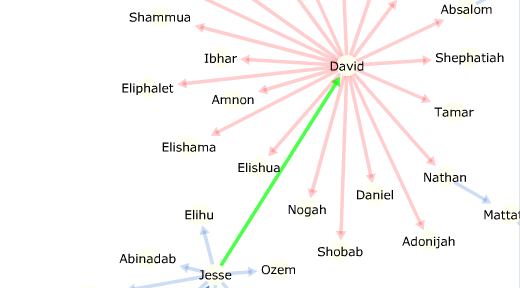
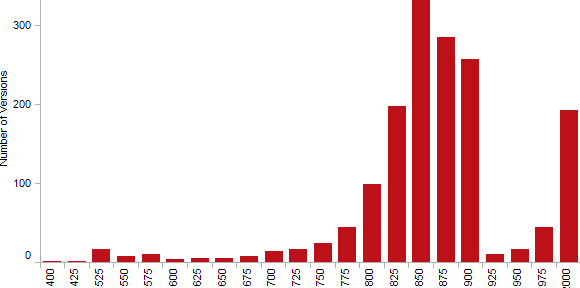
I’m a little late joining the bandwagon on celebrating the 400th anniversary of the KJV, but here’s my contribution to the mix. I found an interesting web site called Bible Reader’s Museum which, among other things, has extensive listings of Bible versions throughout time. Being the chart junkie that I am, I converted their English Bible version list (used by permission) to an interactive graph of versions over time. It begins at quarter-century intervals and then changes to smaller intervals as you filter out the years. The list at the bottom filters along with it, making it simple to find one or several, then click the name to go to that version’s website. It’s amazing to see just how many translations there have been over the years. Take a look!
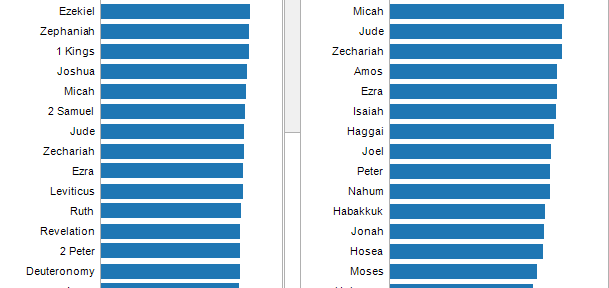
There are numerous claims about the readability of various English Bible translations. The chart below is the result of my own calculations using the standard Flesch-Kincaid grade level formula. Many other readability calculations do not specify whether sentence lengths are based on punctuation or verse divisions. This tool allows you to see it either way. In some sections, the results are wildly different.
This tool also makes it easy to find readability levels for each author, book and chapter (on the advanced tab), unlike the more general readability comparisons you may have seen already. Due to copyright restrictions, it is difficult to obtain electronic versions of the entire text of translations other than the KJV, so at the moment we do not have a simple tool available for comparing readability accross different versions.
(chart may take a moment to load)
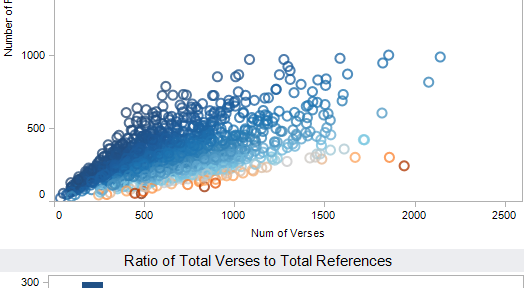
The Christian scriptures are interconnected in deep and meaningful ways which can sometimes be hard to discover. Scholars have compiled hundreds of thousands of cross-references over time, and modern computer whizzes have charted these references in beautiful and engaging displays. I have taken a new approach, which you can see below. It displays three measures: the number of verses in each chapter, the number of cross references in each chapter, and the ratio between the two.
In a moment I will share a few examples of the insights this visualization affords, but first I’ll explain how I arrived at the idea for making this particular interactive tool. I began working several months ago to compile available data into what I call MetaV. The eventual goal is to link descriptive information to every word in the Bible and to help users interact with it in such a way that they can see the “big picture” of any passage, including people, places, things, and even cross-references. Naturally, this led me to google “bible cross reference data.” Hit #1: Chris Harrison’s visual showing over 63,000 references with colors indicating the canonical distance between the chapters and bars showing the length of each chapter.
Immediately, I was hooked on it. I’ll confess: it still graces the background of my computer desktop. The reason I was so mesmerized is that he has packed a lot of information into a display that is simple at first glance then grows more complex and informative as you zoom in. It conveys the fact that the Bible is an interconnected whole. The density in some areas gives a general sense of which books may be interesting to us because they were meaningful enough for many other books to refer to it. And that nice, long, thin line towards the middle representing Psalm 119 just begs for attention while happily providing an axis of symmetry. It is art that fulfills it designer’s stated goal:
…we set our sights on the other end of the spectrum –- something more beautiful than functional. At the same time, we wanted something that honored and revealed the complexity of the data at every level –- as one leans in, smaller details should become visible.
Mr. Harrison was kind enough to get me in touch with his collaborator, Christoph, who in turn provided the data behind the graphic (which had been updated to include over 80,000 records). Yet, I was also aware that this many cross references might not be enough for me. Further searching brought me to two more visualizations of a much larger data set – over 340,000 cross references. The first is from OpenBible.info, the same site which is the source for my Bible Places explorer. The second is found on the ESV Blog. Both of these are interesting in their complexity and verse-level detail, which adds a degree of information not contained in Chris Harrison’s work. However, they both have a lot of redundancy – one could easily cut the visuals in half and get just as much information.
All of these are more useful in terms of artwork than for visual analysis and in-depth exploration. My expertise is in crunching numbers, not so much in making beautiful displays of them. I wanted to modify the idea of graphing hundreds of thousands of pieces of information in a way that makes certain aspects of it stand out. Just to make it a challenge, I combined the two data sets I found into one massive table containing 412,100 references once I filtered out duplicate records. The outliers you see above are chapters of the Bible which stand out here but would be lost in the haystack within the visualizations I’ve mentioned. While mine is nothing more than an interactive version of common graphical displays, it makes it easy for our eyes and minds to identify interesting points.
Right away, you can see that Psalm 119 lies lonely at the top-right because it is by far the longest chapter of the Bible and consequently has the most cross-references related to it. The orange circles stand in contrast because they have proportionately fewer cross references than other chapters. We might expect those to be the ones which are nothing more than long, detailed genealogical records. Two of the noticeable outliers fits that expectation (1 Chronicles 7&8) , but the others do not.
1 Chronicles 3, the brightest orange circle, is the chapter which details the construction of Solomon’s Temple. Exodus 36&37, two other orange marks, give specifics about making the Tabernacle and the Ark of the Covenant. The dimensions and construction materials of these things are rife with metaphors. Perhaps their symbolism is linked to other portions of scripture in ways we do not yet know an have not catalogued, or maybe they should continue to stand alone due to their uniqueness. On the other end of the spectrum, Romans 12 has more cross references for each verse than any other chapter. When you read it, you’ll understand why. On average, every single verse has more then one reference associated with it. In all, 77 chapters of the Bible fir in that same category.
These are just some of the things that can lead a student of the Lord to discover more about him. We can search out the things we may normally pass over but which stand out in an analysis such as this. What can you find by searching through, selecting, and zooming in on these plots? What might you learn that you would otherwise overlook? Please leave a comment if you happen upon something interesting or the Lord blesses you in some way as a result of your studying these visuals.

Even though the Ark of the Covenant is long lost, you can still explore it virtually. In this study tool you can find info about the ark, its history, symbolism, and contents.
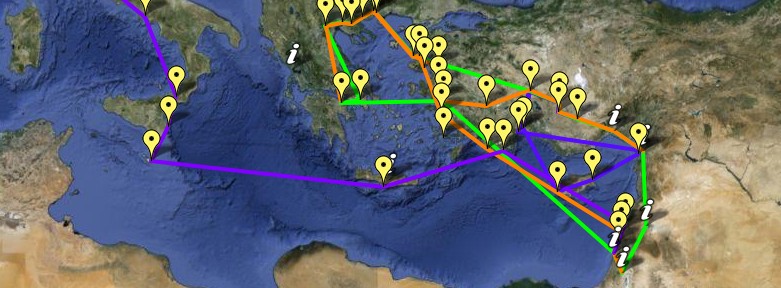
View Paul’s Life and Journeys in a larger map
While you explore the map above, below are some observations to take note of.
If the Lord has shown you something interesting that’s not in this list, we’d love for you to tell us about it!
Source info: Biblestudy.org (not affiliated with this website)
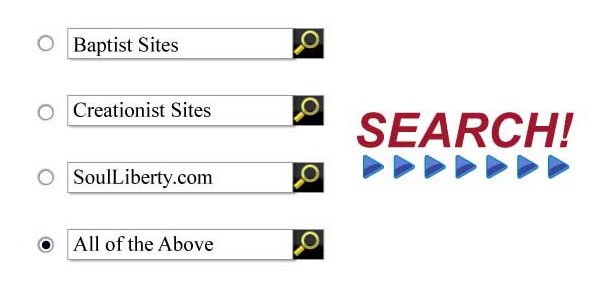
It can be difficult to wade through search results to find quality answers to questions about God and the Bible. Use this Google Custom Search engine to find the answers you’re looking for from over 15 million pages on websites specifically selected for their trustworthiness on Christian topics.